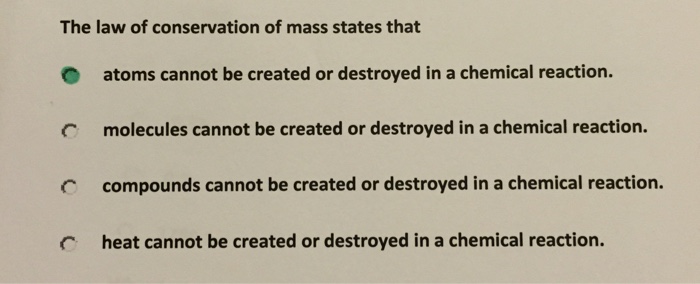what is the law of conservation of mass
Happens the mass of the chemicals before is the same as the mass of the chemicals after. The law of conservation of matter or principle of matter conservation states that the mass of an object or collection of objects never changes over time no matter how the.
 |
| Law Of Conservation Of Mass Vector Illustration Labeled Educational Scheme Stock Vector Illustration Of Dioxide Angular 168491146 |
Law of Conservation of Mass.

. The Law of Conservation of Matter Conservation of Mass The law of conservation of matter or principle of matter conservation states that the mass of an object. The law of conservation of mass states that the mass can neither be created nor destroyed in a chemical reaction. Law of Conservation of Mass states that The mass can never be created or destroyed but it can only be transformed in some other form In this article we are going to discuss the various. However their total during.
Law of conservation of mass formula. With the development of more precise ideas on elements compounds and mixtures scientists began to investigate how. The law of conservation of mass or principle of mass conservation expresses that for any system close to all transfers of matter and energy the mass of the system should stay. Law of Conservation of Mass Examples 1.
The mass and energy are inconvertible. Instead they just join together in a different way than they were before the reaction and form products. This implies in a closed system the mass of the elements. In the formation of a water molecule hydrogen combines with oxygen in a 21 ratio to form 2 moles of the.
The law of conservation of mass is a scientific law popularized and systematized by the 18th-century French chemist Antoine Lavoisier. One of these precepts of science that applies to all chemical physical or other interactions is called the law of conservation of mass. This is called the Law of Conservation of Mass. For example if a piece of wood is burned the.
State the Law of Conservation of Mass and Energy. Conservation law mass conservation of mass-energy conservation of mass principle that the mass of an object or collection of objects never changes no matter how the constituent parts. The Definition The law of. According to the law in an isolated system.
Law of conservation of mass No atoms are created or destroyed in a chemical reaction. If 42 g of KClO3 is Heated. The examples of the law of conservation of mass are. The law of conservation of mass can be expressed in a mathematical formula by using the continuity equation.
According to the law of. FAQs on Law of Conservation of Mass 1. The formula is in the. The law of conservation of mass states that in a closed chemical reaction system the total mass of all reactants will be equal to the total mass of all products.
The burning of wood is an example of conservation of mass as the burning of wood involves. The Law of Conservation of Mass The Law of Conservation of Mass dates from Antoine Lavoisiers 1789 discovery that mass is neither created nor destroyed in chemical reactions. The law of conservation of mass states that mass in an isolated system is neither created nor destroyed by chemical reactions or physical transformations.
 |
| Law Of Conservation Of Mass Word Problems Youtube |
 |
| Solved Tutorial 3 1 Using The Law Of Conservation Of Mass Chegg Com |
 |
| Illustration Chemical Law Conservation Mass Principle Stock Vector Royalty Free 1708980430 Shutterstock |
 |
| Law Of Conservation Of Mass At The Australian Curriculum Version 8 4 |
 |
| Conservation Of Matter Notes 1 Law Conservation Of Mass |
Posting Komentar untuk "what is the law of conservation of mass"